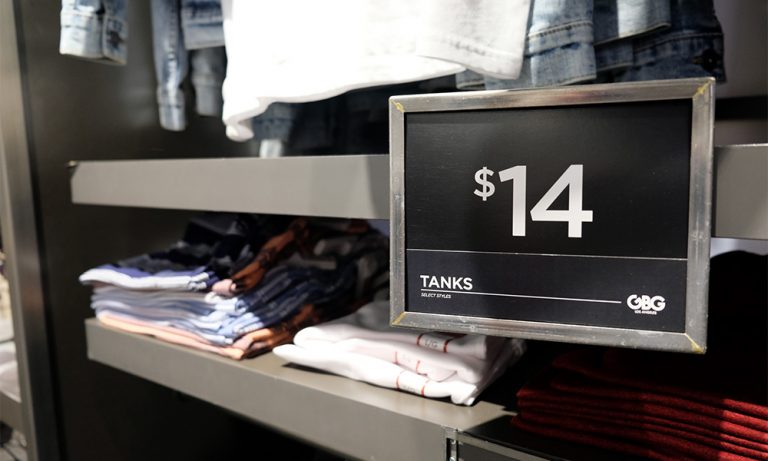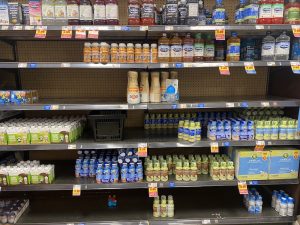The following is an excerpt from a Beat Basics Update originally by Ylan Q. Mui and updated by Yael Grauer on covering retail.
The good news about covering retail is that it’s one of the most accessible beats in business: We all buy stuff, so both reporters and readers have a basic understanding of how the industry works. But the retail beat is about much more than going to the mall. It is about how merchandise is manufactured and transported around the globe. It is about new technologies that are changing the way we buy products and how we pay for them. It can tell the story of a local mom-and-pop or of the biggest company in the world, Walmart. It delves into psychology to explain brand identity – Starbucks or Dunkin Donuts? – and captures our cultural zeitgeist.
Recessions remind us that shoppers remain at the heart of our country’s economy. How we choose to spend – or not spend – our money speaks volumes about the nation’s financial health. The boom years gave birth to $300 designer jeans. The bust spawned extreme couponing. Retail reporting requires the ability to parse economic and market data to unveil hidden truths about the state of the nation.
This Beat Basic will help you understand the most common types of retail stories and provide you with ideas for approaching them in a fresh way. It will cover the challenges of the beat, from ways to gain access to a store to walking the fine line between reporting a trend and promoting a product. This introduction to the retail beat will also explain jargon and break down the sales reports and economic data released each month. And of course, it will also cover the all-important Christmas shopping season. (Hint: It’s never too early to start thinking about the holidays!)
Retail is one of the most fun beats on the business desk. I hope you will enjoy it as much as I have.
COVERING RETAILING: THEMES AND KEY ISSUES ON THE BEAT
There are several common types of retail stories that you will encounter on your beat. If you’ve been assigned a retail story and are jumping in cold, chances are it fits into one of these models. I’ll give an explanation of each issue with tips on how to approach the story.
TRENDS
Trends may come and go, but the trend story is a staple of retail reporting. It may take the form a local angle on a national trend, such as rising food prices or the advent of Animal Crossing. Or you may have spotted something unique to your community. I once wrote about a neighborhood where dozens of kids set up dueling lemonade stands and their selling techniques, including carside service, charity tie-ins and price discounting.
There are two elements to a strong trend story: people and hard numbers. Without colorful examples and anecdotes, you’re left with a dull research report. If you don’t have a few statistics backing up your premise, you don’t have a business story!
Finding numbers is often easier than finding people. There are a host of market research firms that collect data on everything from neckties to energy drinks. Local business owners are also often more willing than big companies to share sales and customer data with you. In my lemonade stand story, I learned that one of the children spent a weekend counting the cars that drove by his house to help him figure out how much lemonade he needed to make and how much to charge.
Finding people to illustrate a trend often requires plain old shoe leather. I’ve accosted people in supermarkets and shopping malls, lurked on listservs and crashed MeetUp groups. I’ve also put together a database of “real people,” friends, acquaintances and sources with large social circles who, more often than not, know someone willing to be interviewed for a story.
STORE OPENINGS
Opening a store is a huge investment – not to mention a gamble – for any business owner. There is an inevitably complicated permitting process, a lengthy and expensive build out of the space, the acquisition of merchandise, a search for talented staff and finally a hope and a prayer that customers show up.
Each of these stages is an important element in the opening of a store: What did it take for local officials to approve the store? Was there any opposition to it? Will it be receiving any government money? What demands did local officials want from the retailer and vice versa? It is not uncommon for a merchant to request a certain traffic pattern, or for local officials to put restrictions on signs and billboards.
Also important are the types of products the store will carry. Will it be a new prototype for future stores? Is the company testing any merchandise in this store? Has it tailored its selection to the community, for example, by stocking more ethnic food in diverse neighborhoods or larger pack sizes to cater to harried moms? A smart retailer will make each store unique – and a smart shopper will notice! The tough economy has brought renewed focus to retail’s role in creating jobs. A strong story will include not only the number of people the store hires, but also address wages and employee selection. Many cities will ask large retailers to set aside a certain number of jobs for residents.
In addition, many grocery stores are unionized. If a new supermarket is opening, it may be worthwhile to find out whether it is part of a union and speak to local labor leaders.
STORE CLOSINGS
More common than store openings in recent years are store closings, one of the consequences of a recession as well as consumers increasingly shopping online. A store closing sets a different chain of events into motion, each ripe with stories. A large store closing may result in a Worker Adjustment and Retraining Notice (WARN) to your state unemployment office 60 days before it shuts down. This may be your first tip that a major retailer in your area will be closing. The impact of those layoffs to your community will be an important thread to follow. You may also want to check with local officials on the loss of sales tax revenue from the store.
Large retailers often outsource store liquidations to special firms. Those firms frequently bring in outside merchandise to sell along the store’s original products, a practice that irritates many consumers. You may also want to track what happens to the things that don’t sell, no matter how deeply they are discounted. There is an entire industry for liquidated merchandise that is fascinating to dive into.
Most retailers do not own the building in which they operate. You should seek out the landlord to find out what will happen to the space and how much rent they can hope to claim. Local officials may also weigh in on the impact of a blighted store front on the community. No business owner wants to be next to an empty space.
NEW TECHNOLOGY
Retailing is an intensely competitive field, and stores are always looking for innovations that can help them reduce costs or sell more products. That means they are often the first adopters of new technologies, from global tracking devices that monitor the shipment of merchandise to mobile coupons to Facebook credits.
These stories tend to have a “gee-whiz” feel to them, but don’t forget to ask whether a fancy new technology actually results in higher sales or lower costs. Otherwise, it might not be around for long. Sometimes, old innovations can make for interesting stories as well. In 2011, New York Times retail reporter Stephanie Clifford wrote a front-page story on rethinking the store mannequin: Stores Demand Mannequins with Personality (Heads Optional). During the Great Recession of 2008, several retailers reinstated layaway in their stores upon customer demand: The Return of Layaway Shopping.
HOLIDAYS
We’re not just talking Christmas. Every month seems to bring a special shopping occasion: the Super Bowl, Valentine’s Day, Mother’s Day, Independence Day, back-to-school season – you get the picture. As a retail reporter, you will often be asked to find a new angle on an event that happens every year. Some common stories include how much consumers plan to spend during the holiday and what they plan to buy.
If you’re lucky, a new product or catchy advertising campaign will emerge that allows you to write a trend story. But you can also do the opposite: Explore the history of an old favorite. For example, one holiday season the Times-Picayune in New Orleans wrote about the origins of the “turducken,” a chicken stuffed inside a duck stuffed inside a turkey that had long been a local staple but became famous nationally.
Often, holiday stories are not about what’s new and different but simply about what is interesting. You could shadow a florist on Mother’s Day, follow a harried mother shopping for school supplies or make chocolates at a local confectioner for Valentine’s Day. As reporters we may try too hard to find something new when readers (and your editors) are seeking the familiar.
E-COMMERCE
Covering retail is no longer limited to simply brick-and-mortar stores. E-commerce increasingly impacts every industry, whether it’s stores adapting to competition or learning how to compete with Amazon by improving their websites and online stores, or chains downsizing in response to lower foot traffic due in part to online retailers.
E-commerce has many benefits for consumers, who can shop online without leaving their home more quickly, and are more likely to find specialty items that may be difficult to find in their region. They can also compare prices more easily and take advantage of discount codes as well as free shipping offers, ultimately saving money. Recommendation systems can help some people find more items they’re interested in buying based on their past purchase history (or views). But e-commerce can be difficult for people who enjoy face-to-face interaction or who want to try on clothing in person. Returning products bought online can also be inconvenient.
The use of cardboard and other packaging materials has had an impact on the environment. Additionally, retail workers have lost jobs while the development of e-commerce increases jobs at warehouses as well as software applications, digital products and other information-related services.
E-commerce growth has experienced unprecedented growth in response to the COVID-19 pandemic. It’s worth tracking whether customers continue to shop online rather than in-person in the future or if this shift is somewhat permanent.










